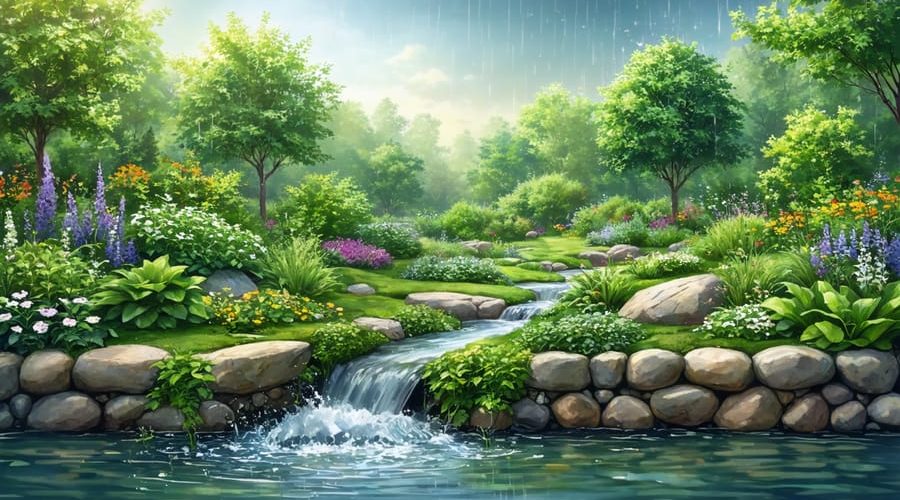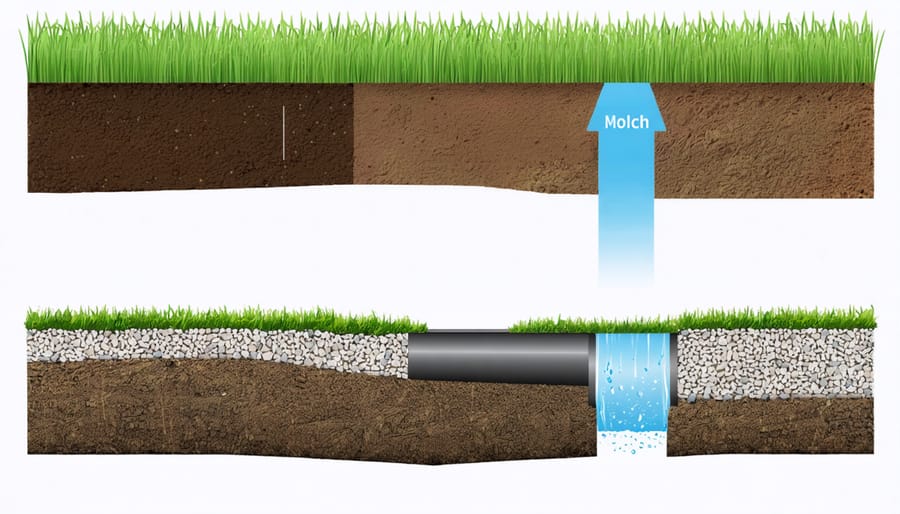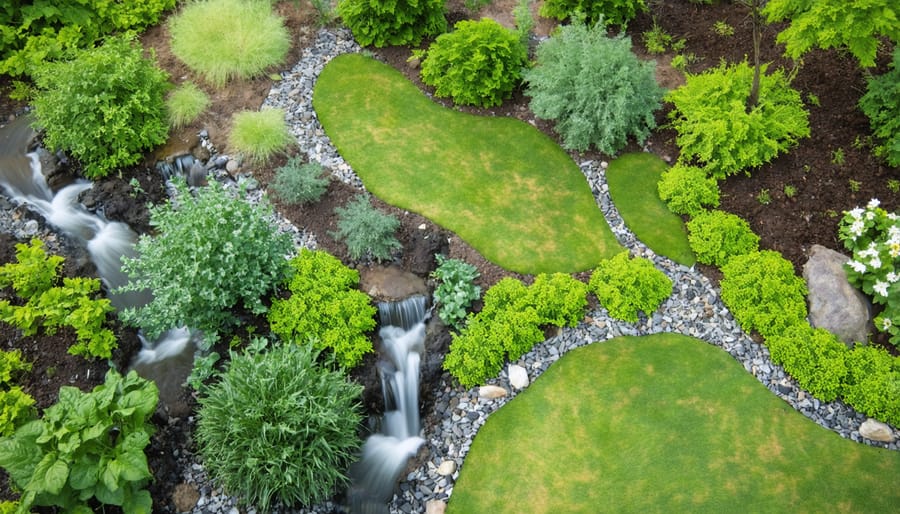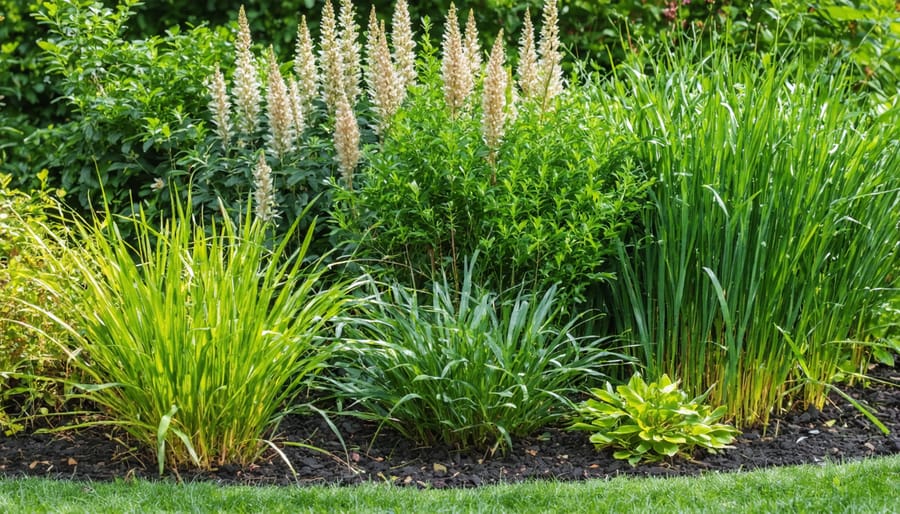
Beautiful Bioswales: Transform Your Garden into a Natural Water Filter
Transform your outdoor space into a living water filtration system with bioswales and rain gardens – natural, beautiful solutions that protect our waterways while enhancing your landscape. These innovative features of sustainable gardening practices capture rainwater runoff, prevent flooding, and create thriving habitats for local wildlife.
Unlike traditional gardens, bioswales and rain gardens work as engineered depressions in the landscape, utilizing layers of soil, plants, and natural filtration to clean stormwater before it enters our groundwater system. Native plants with deep root systems thrive in these environments, creating a low-maintenance, eco-friendly addition to any property.
Whether you’re dealing with drainage issues or simply want to contribute to environmental conservation, these water-smart gardens offer a practical solution that combines functionality with natural beauty. From small urban yards to sprawling suburban landscapes, bioswales and rain gardens can be scaled to fit any space while providing essential ecosystem services.
Let’s explore how you can harness the power of nature to manage water runoff while creating a stunning, environmentally responsible landscape that works in harmony with natural water cycles.
How Bioswales and Rain Gardens Work
Natural Water Filtration Process
Nature has perfected the art of water filtration, and bioswales and rain gardens harness these powerful natural processes. As water flows through these carefully designed spaces, it undergoes a remarkable transformation through multiple filtering layers. The process begins with plants, whose roots act like tiny sieves, catching debris and pollutants while absorbing excess nutrients. These plant systems are crucial for sustainable water management in your garden.
Below the surface, different soil layers work their magic. The top mulch layer catches larger particles, while the specially mixed soil beneath contains sand, organic matter, and clay that trap smaller contaminants. Beneficial bacteria that naturally occur in the soil break down pollutants and transform them into harmless substances.
As water slowly percolates through these layers, it’s not just being cleaned – it’s also being stored and gradually released into the groundwater. This slow-release process helps prevent flooding and ensures that the filtered water reaches our aquifers naturally. Think of it as nature’s own water purification system, working tirelessly in your backyard to keep our water clean and healthy.

Flood Prevention Benefits
Bioswales and rain gardens are natural heroes when it comes to preventing flooding in your neighborhood. These landscape features act like miniature flood control systems, capturing and managing stormwater runoff that would otherwise overwhelm storm drains or flood low-lying areas.
When rain falls on impervious surfaces like roofs, driveways, and sidewalks, it needs somewhere to go. Rather than rushing straight into storm sewers, these garden features collect the water and allow it to slowly seep into the ground. A well-designed rain garden can absorb up to 30% more water than a standard lawn, while bioswales can handle even larger volumes during heavy storms.
Think of these systems as nature’s speed bumps for water. The special soil mixtures and deep-rooted plants work together to slow down water flow, filter out pollutants, and gradually release the cleaned water into the ground. This process not only prevents flooding but also reduces erosion and protects local waterways from contamination.
For homeowners, this means drier basements, less water pooling in yards, and reduced strain on municipal drainage systems. Plus, you’re helping your community by managing water right where it falls!
Planning Your Bioswale or Rain Garden
Choosing the Right Location
Selecting the perfect spot for your bioswale or rain garden is crucial for its success. Start by identifying low-lying areas in your yard where water naturally collects after rainfall. These natural drainage paths make ideal locations, as they’ll efficiently capture and filter runoff.
Keep your rain garden at least 10 feet away from your home’s foundation to prevent water damage. Also, avoid placing it directly over septic systems or utility lines. The area should receive partial to full sun for optimal plant growth.
Test your soil drainage by digging a hole about 12 inches deep, filling it with water, and monitoring how quickly it drains. If water sits for more than 24 hours, you’ll need to improve drainage before installation. Sandy or loamy soils are ideal, but clay soils can work with proper amendments.
Consider visibility from your home and outdoor living spaces – these features can be beautiful focal points in your landscape. Also, think about maintenance access; you’ll want to reach your garden easily for weeding and upkeep.
Size and Shape Considerations
When planning your bioswale or rain garden, size matters! A good rule of thumb is to make your garden about 20% of the drainage area it will serve. For example, if you’re collecting runoff from a 500-square-foot roof, aim for a 100-square-foot garden.
Shape-wise, think long and narrow for bioswales, typically following natural contours of your land. For rain gardens, you have more flexibility – oval, kidney-shaped, or round designs all work well. The key is ensuring the bottom is level to allow even water distribution.
Depth is crucial too. Most rain gardens work best at 4-8 inches deep, with gently sloping sides at a 3:1 ratio (that’s 3 feet of horizontal distance for every 1 foot of vertical drop). This creates stable edges that are easy to maintain and mow around.
Remember to keep your garden at least 10 feet away from building foundations and avoid placing it over utility lines or septic systems. If you’re working with a particularly wet area, consider creating a series of smaller connected gardens rather than one large one.

Soil Testing and Preparation
Before starting your bioswale or rain garden project, proper soil testing and preparation are essential for success. Start by conducting a simple percolation test: dig a hole about 12 inches deep, fill it with water, and time how long it takes to drain. Ideally, the water should drain within 24-48 hours.
Your soil should be well-draining but also capable of supporting plant life. A mix of 50-60% sand, 20-30% topsoil, and 20-30% organic matter usually works best. If your soil is heavy clay, you’ll need to amend it with sand and compost to improve drainage. For sandy soils, add organic matter to help retain moisture.
Test your soil pH, which should typically be between 5.5 and 7.0 for most rain garden plants. Also check for soil contaminants, especially if you’re in an urban area or near a road. When preparing the site, remove existing grass and weeds, then dig down about 18-24 inches. Grade the soil so water flows naturally into your garden area, creating a gentle bowl shape that’s deepest in the center.
Remember to call your utility company before digging to check for underground lines or pipes.
Best Plants for Bioswales and Rain Gardens

Native Water-Loving Plants
Choosing the right native water-loving plants is crucial for creating a successful bioswale or rain garden. These plants not only add beauty but also play a vital role in filtering water and preventing soil erosion.
For sunny areas, consider Purple Coneflower, which attracts pollinators while providing strong root systems. Swamp Milkweed offers beautiful pink blooms and serves as a monarch butterfly magnet. Joe-Pye Weed, growing up to six feet tall, adds dramatic height and purple flower clusters that bloom late summer.
In partially shaded spots, Blue Flag Iris thrives with its striking purple-blue flowers and sword-like foliage. Cardinal Flower brings brilliant red blooms that hummingbirds absolutely love. For ground cover, try Marsh Marigold, which offers cheerful yellow flowers in spring.
Don’t forget about sedges and rushes – these grasslike plants are workhorses in water filtration. Fox Sedge and Soft Rush are particularly effective at slowing water flow and trapping pollutants. For year-round interest, include Switch Grass, which provides winter structure and beautiful fall colors.
Remember to group plants based on their water needs – place those tolerating the wettest conditions at the bottom of your garden, with more drought-tolerant species along the edges. This creates natural zones that match your garden’s moisture gradient.
Maintenance-Friendly Options
When it comes to low-maintenance plants for your bioswale or rain garden, native species are your best friends. These plants have evolved to thrive in your local climate and typically require minimal care once established. Consider sturdy perennials like Black-Eyed Susans, Purple Coneflowers, and Switch Grass, which naturally resist local pests and diseases.
Sedges and rushes are excellent choices as they can handle both wet and dry conditions. They develop deep root systems that help filter water while requiring little attention. Joe-Pye Weed and Cardinal Flower not only attract pollinators but also bounce back easily from heavy rain events without needing much maintenance.
For ground cover, try spreading plants like Creeping Jenny or Wild Ginger, which naturally suppress weeds and reduce the need for manual weeding. Native ferns are another fantastic option for shaded areas, as they’re naturally adapted to thrive under tree canopies and need minimal care.
To further reduce maintenance needs, group plants with similar water requirements together. This smart planning prevents over or under-watering issues. Adding a 2-3 inch layer of organic mulch around your plants helps retain moisture, suppress weeds, and slowly feed your plants as it breaks down.
Remember, while these plants are low-maintenance, they’re not no-maintenance. A quick monthly check for invasive species and occasional pruning of dead growth is usually all that’s needed to keep your garden looking its best.
Maintaining Your Sustainable Water Garden
Seasonal Maintenance Tasks
Keeping your bioswale or rain garden in top shape requires different tasks throughout the seasons. In spring, start by removing dead plant material and winter debris, then add a fresh layer of mulch to retain moisture. Check for and repair any erosion damage that winter might have caused. This is also the perfect time to divide overgrown perennials and add new native plants.
Summer maintenance focuses on weeding and ensuring proper water flow. While these gardens are designed to handle water naturally, during dry spells you might need to water deeply, especially if plants show signs of stress. Following simple water sustainability tips can help you manage this efficiently.
Fall calls for removing fallen leaves and cutting back spent perennials. Leave some seed heads for winter interest and bird food. Clean out drainage channels and check that water still flows freely through the system.
Winter is relatively low-maintenance, but keep an eye on snow and ice buildup. Remove any debris that might block water flow during spring thaw. This is also a great time to plan next year’s improvements and research new plant additions for spring.
Remember to inspect the soil and drainage monthly throughout the year, ensuring there’s no standing water after 48 hours of a rain event.
Troubleshooting Common Issues
Even well-designed bioswales and rain gardens can face occasional challenges. Here’s how to address common issues you might encounter:
Standing water that doesn’t drain within 24-48 hours often indicates soil compaction or poor drainage. Remedy this by aerating the soil and adding organic matter to improve percolation. If the problem persists, you may need to install additional drainage pipes or adjust the soil mix.
Unwanted plant growth and weeds can overwhelm your desired species. Regular weeding, especially during the first two growing seasons, helps establish your intended plants. Apply a layer of mulch to suppress weed growth while maintaining moisture levels.
If plants aren’t thriving, check whether they’re receiving appropriate sunlight and if the soil moisture meets their needs. Some plants might be inappropriately placed in terms of water depth or exposure. Consider relocating struggling plants to more suitable spots within the garden.
Erosion around inlet areas can occur during heavy rains. Combat this by placing river rocks or cobblestones at entry points where water flows into your garden. Adding more deep-rooted plants can also help stabilize soil and prevent washout.
For mosquito concerns, ensure proper drainage and consider adding mosquito-eating fish in deeper areas if water retention is part of your design.
Creating a bioswale or rain garden is more than just a landscaping project – it’s an investment in our environment and community. These natural water management systems help reduce flooding, filter pollutants, and create beautiful, low-maintenance spaces that support local wildlife. Whether you have a small backyard or a large property, implementing these features can make a significant impact on water quality and conservation.
By following the guidelines in this article, you can design and build your own bioswale or rain garden that suits your space and needs. Remember to start small, choose native plants, and maintain your garden regularly. Not only will you be creating an attractive landscape feature, but you’ll also be contributing to sustainable water management in your community. Why not start planning your bioswale or rain garden today? Your local ecosystem – and your water bill – will thank you!
